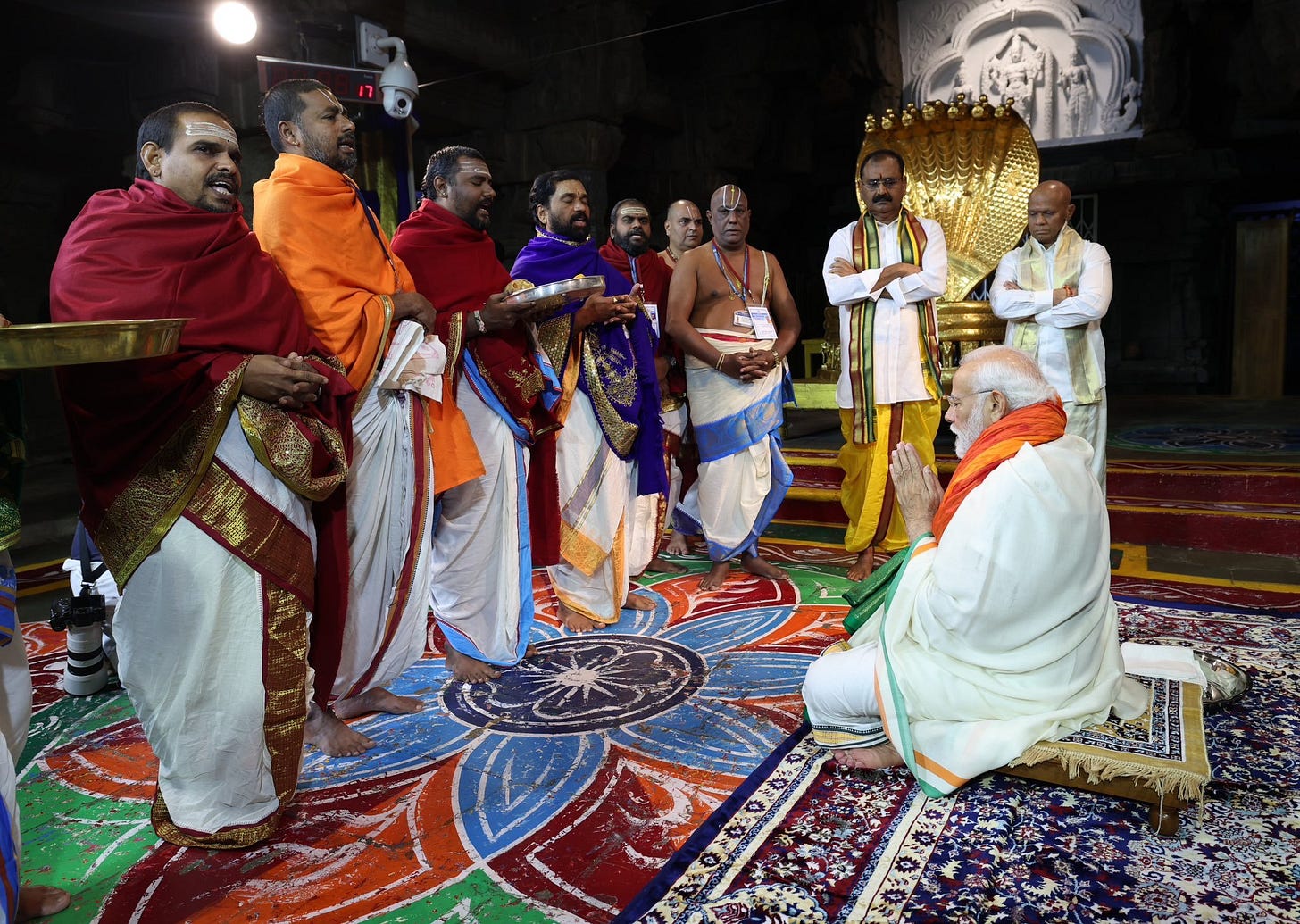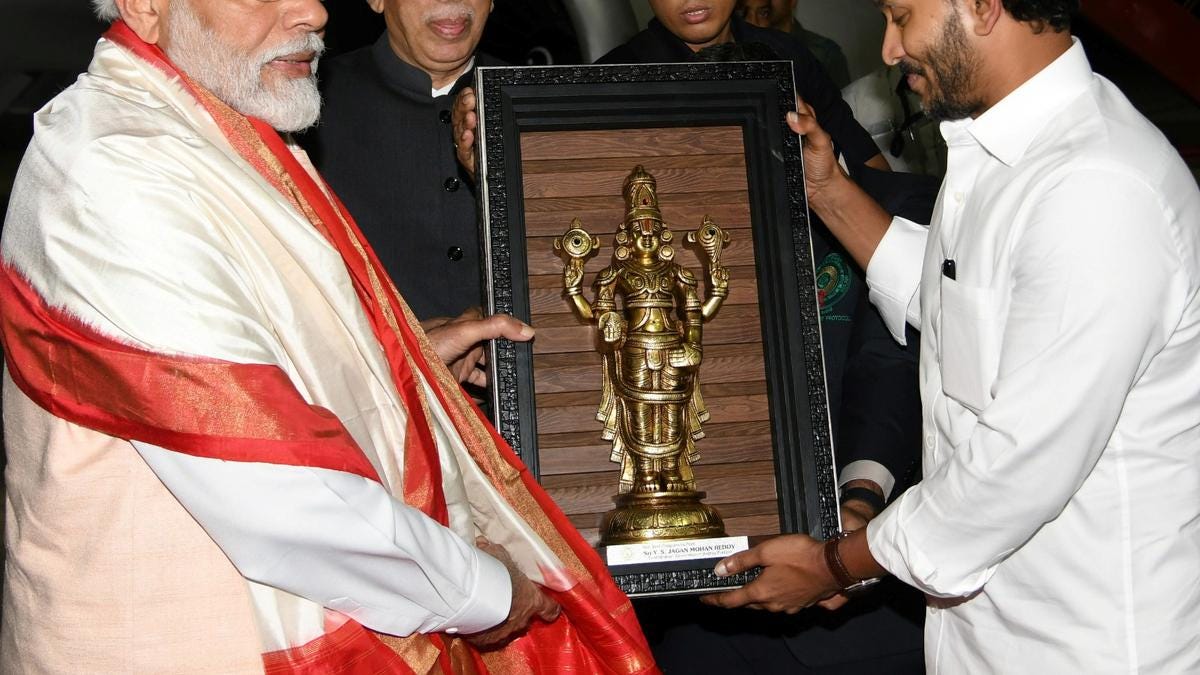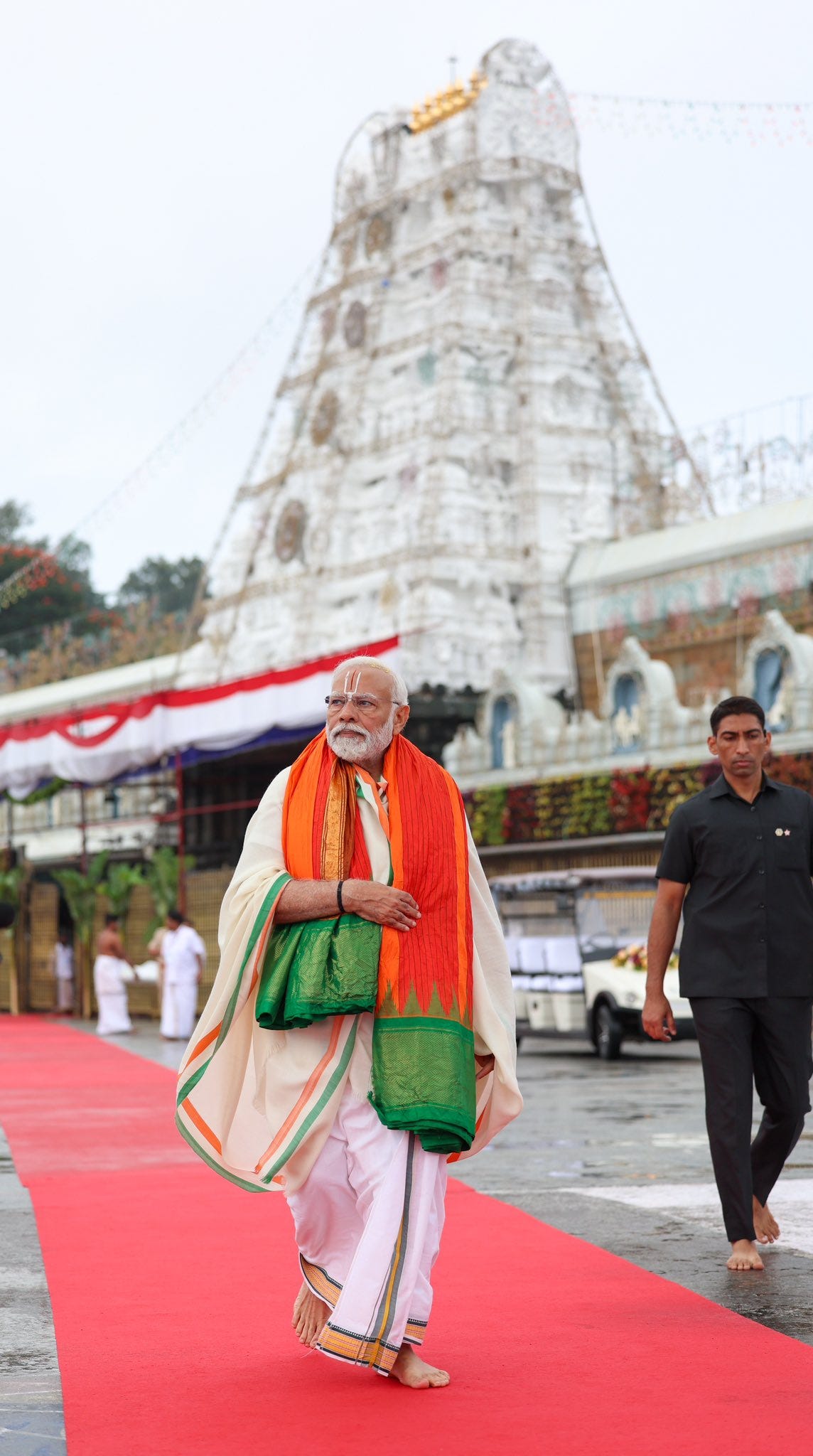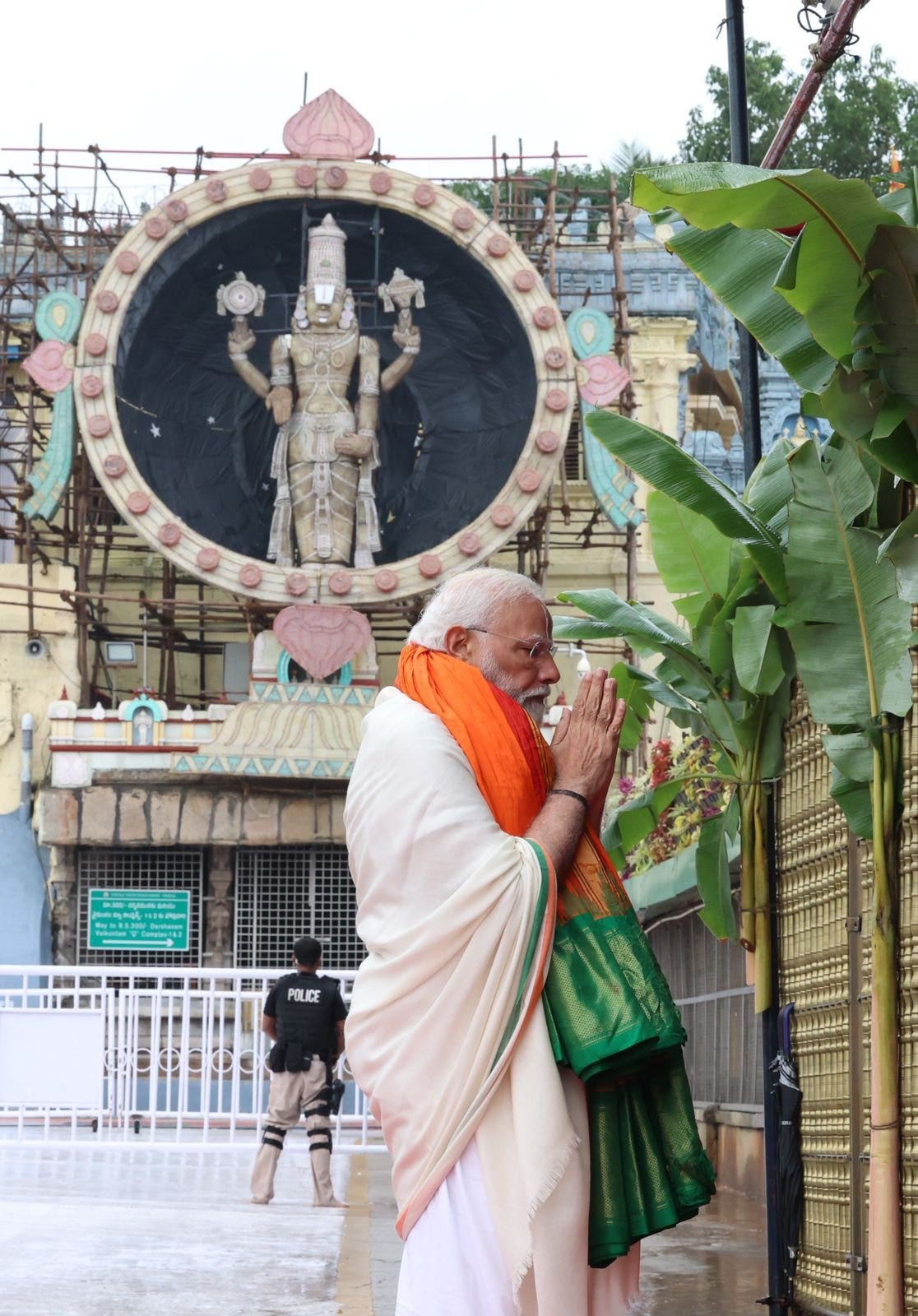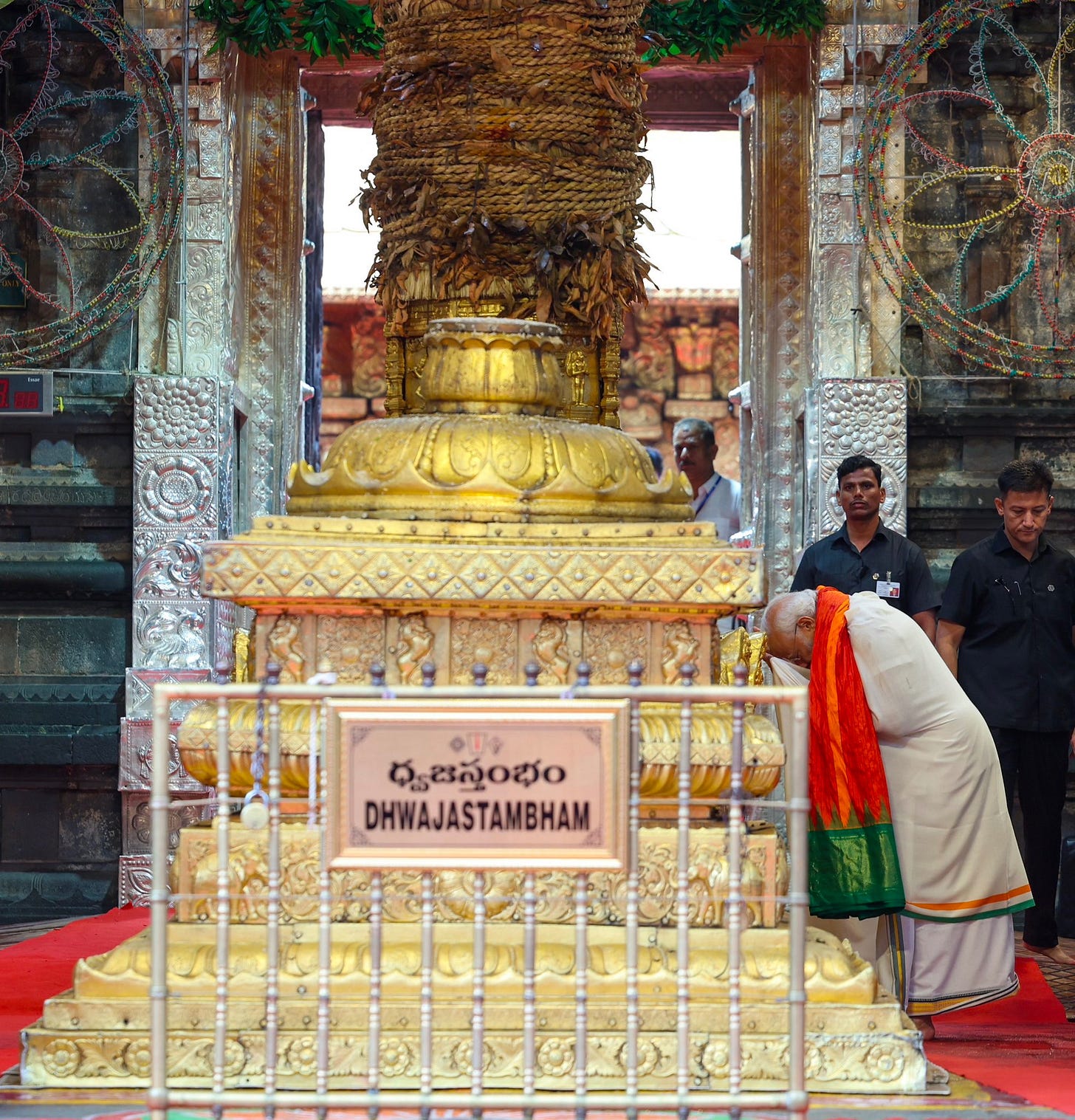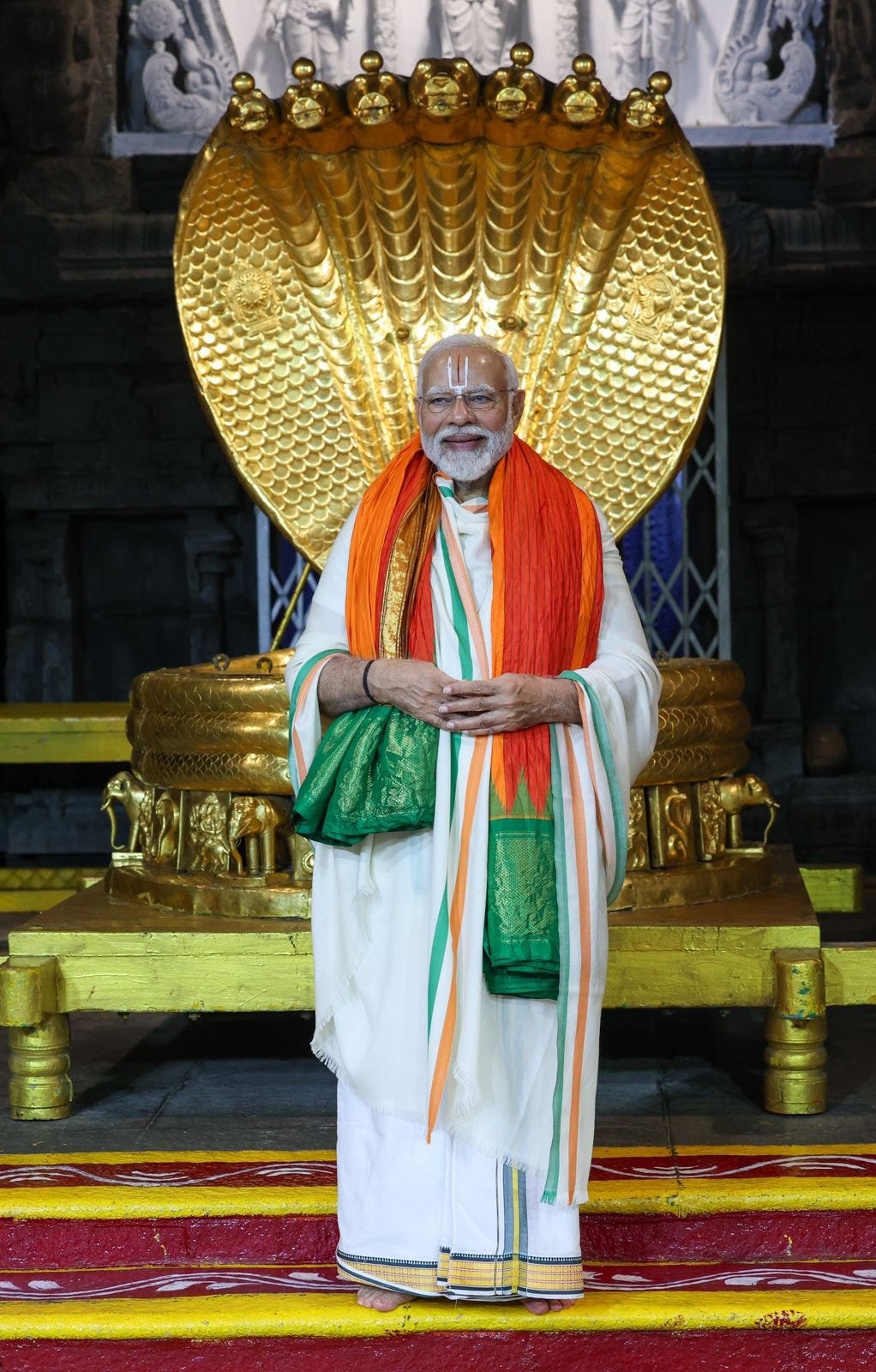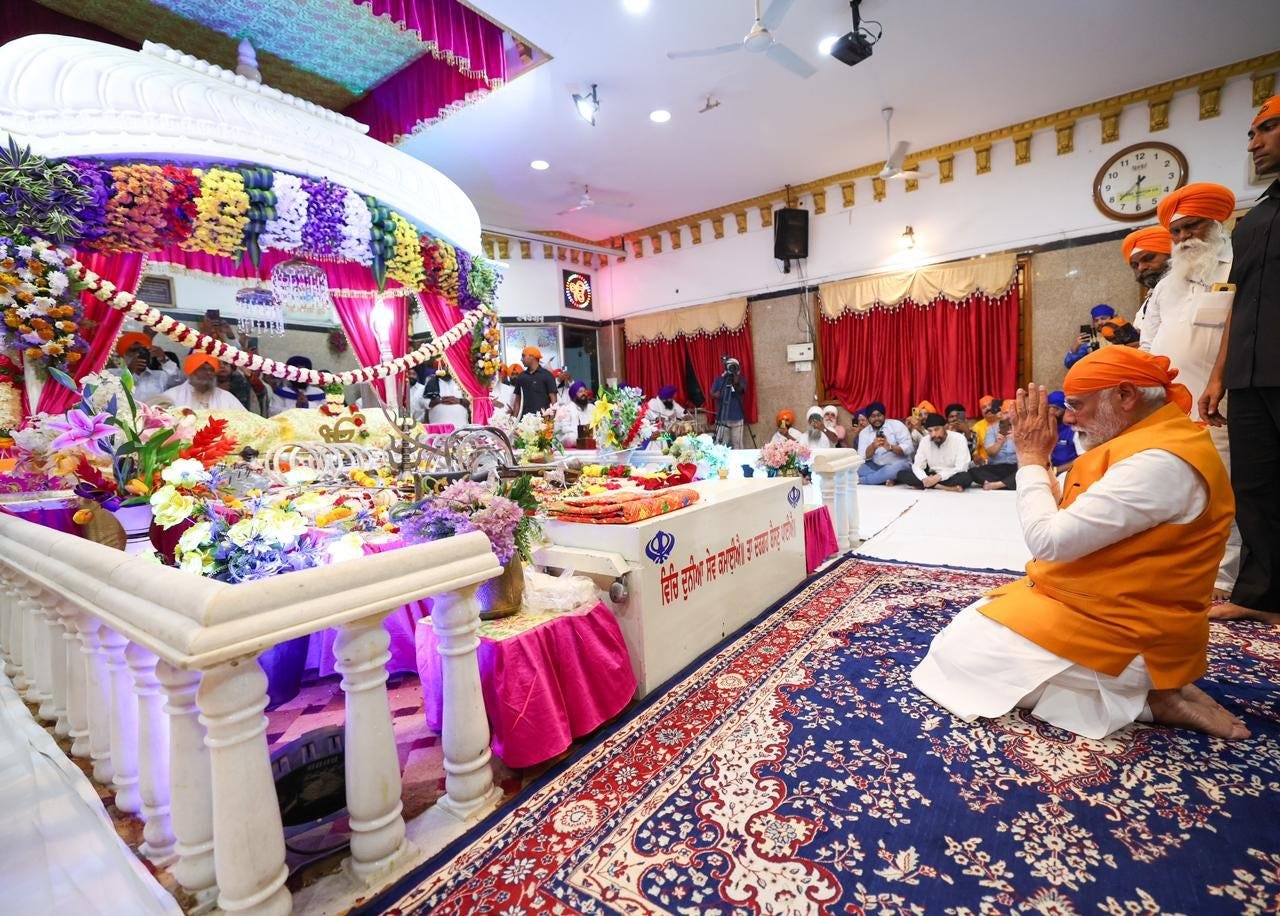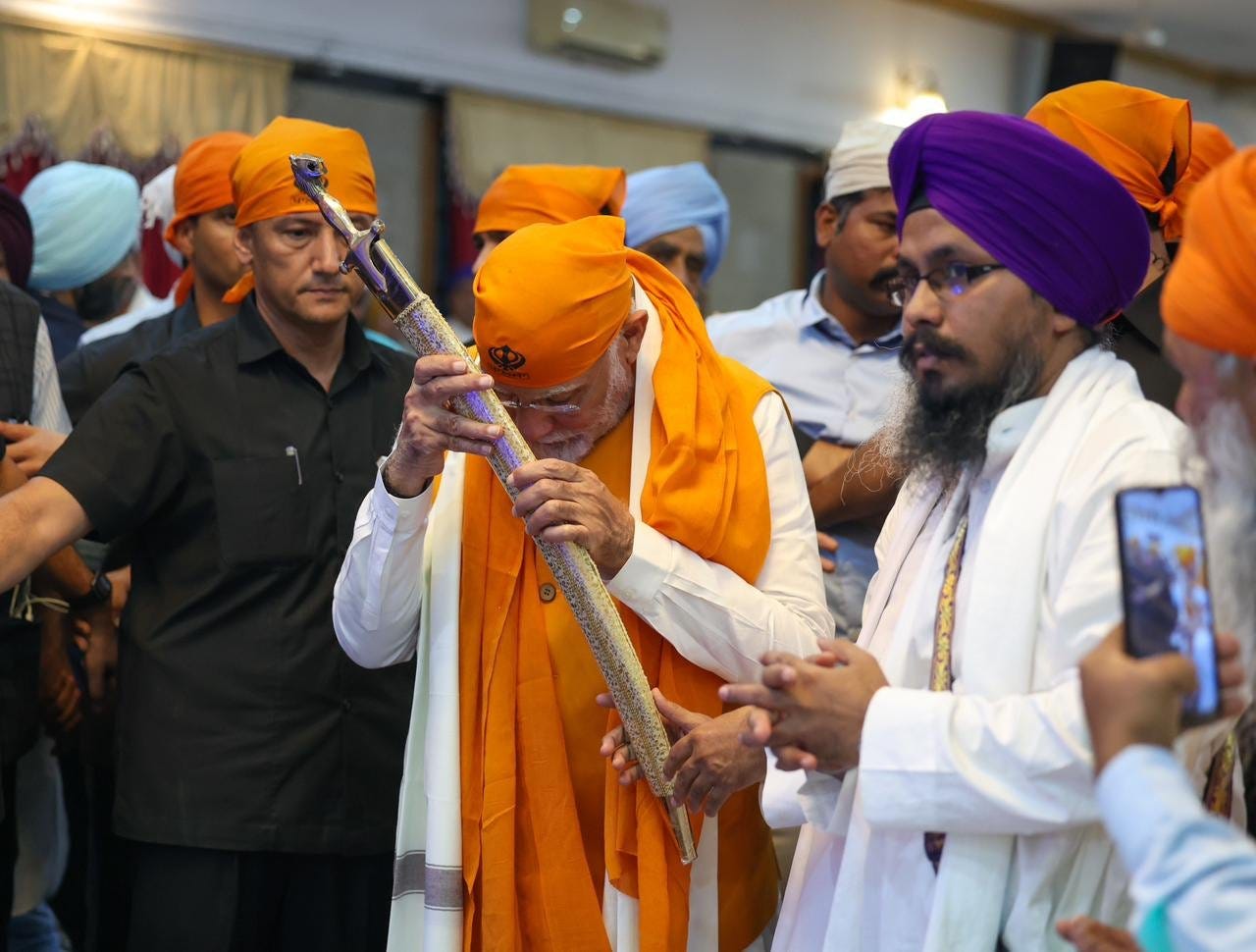PM Modi In Tirupati: Om Namo Venkatesaya!
Praying at the Lotus Feet of Lord Sri Venkateswara in Tirumala for the good health, well-being, and prosperity of 140 crore Indians.
Prime Minister Narendra Modi's Spiritual Visit to Tirumala-Tirupati Amidst ‘Brahmotsavam’
Prime Minister Narendra Modi arrived in the revered temple town of Tirupati on Sunday evening and stayed overnight, immersing himself in prayers at the sacred Sri Venkateswara Swamy Temple in Tirumala on the morning of Monday, 27 November. His visit, coinciding with the major festive celebration of ‘Brahmotsavam’, resonates deeply with cultural and spiritual significance.
Expressing his devotion and the profound spiritual essence of his visit, Prime Minister Modi shared in a tweet, “At the Sri Venkateswara Swamy Temple in Tirumala, prayed for the good health, well-being, and prosperity of 140 crore Indians.” Commencing another tweet with the invocation “Om Namo Venkatesaya!” he underscored his deep reverence and the pivotal role of this pilgrimage in the Indian spiritual landscape. This visit and his words reflect the profound connection and reverence he holds for this esteemed site, a cornerstone of India's rich cultural and religious heritage.
Lord Sri Venkateswara - The Presiding Deity
Form of Lord Vishnu: Lord Sri Venkateswara, the presiding deity, is considered a form of the Hindu god Vishnu. He is also referred to as Balaji, Govinda, and Srinivasa.
Iconography: The idol of Lord Venkateswara is distinctive, with the deity standing on a lotus base, bearing four arms, holding a discus (Sudarshana Chakra) and a conch shell (Panchajanya) in the upper two hands. The lower hands are in a pose that signifies protection and boon-giving.
Unique Features: A striking feature of the idol is its hair, which is believed to be real.
The eyes of the idol of Lord Venkateswara at the Tirupati Temple are covered with a camphor mark known as 'Namam'. This mark is traditionally applied to shield the devotees from the deity's powerful and intense gaze. The ‘Namam’ serves both a symbolic and practical purpose, aligning with the belief that the direct gaze of the deity is overwhelmingly potent.
Tirupati Temple – Architectural and Cultural Significance
Dravidian Architecture: The temple showcases the Dravidian style of architecture, which is eminent in its elaborate gopurams (temple towers), intricate carvings, and majestic halls.
Ancient Origins: Believed to be constructed over many centuries, the temple has received contributions from various dynasties, including the Pallavas, Cholas, and Vijayanagara emperors. Its history is steeped in legend, linking it back to the Kali Yuga.
Laddu Prasadam: The temple is also famous for its prasadam, the Tirupati Laddu, which holds a geographical indication tag due to its unique preparation and religious significance.
Religious and Economic Aspect
Pilgrimage Site: It’s one of the most-visited religious centers in the world, with millions of devotees flocking annually, believing that a visit to the temple brings divine blessings and fulfillment of wishes.
Economic Impact: The temple is also one of the wealthiest in terms of donations received, playing a significant role in the local and regional economy.
Spiritual Importance
The temple is more than just a structure; it's a symbol of faith and devotion, deeply embedded in Hindu traditions and rituals. The annual festivals, like Brahmotsavam, attract devotees from all over the globe, showcasing a blend of spirituality, culture, and tradition.
The Tirupati Temple, thus, stands as a beacon of Hindu faith, its deity Lord Venkateswara symbolizing benevolence and mercy, and the temple itself a testament to India's rich religious architecture and heritage.
Ritual of Hair Offering at Tirupati: A Symbol of Devotion and Humility
Offering hair to Lord Venkateswara at the Tirupati Temple is a very common and significant ritual, and it is practiced by a large number of male devotees, as well as females and children. This ritual, known as 'Tonsure' or 'Mundan', involves shaving off one's hair and offering it to the deity. This act is seen as a gesture of surrendering one's ego and showing devotion to the Lord.
The Tirumala Tirupati Devasthanams (TTD), which manages the temple, has set up several tonsure halls near the temple to facilitate this ritual. It's one of the most visible and unique aspects of pilgrimage to Tirupati, reflecting a deep-seated tradition of devotion and humility. The act of hair offering is so prevalent that Tirupati is often cited as one of the world's largest centers for hair donation.
The Significance of ‘Brahmotsavam’
‘Brahmotsavam’, celebrated at the Tirupati Temple, is one of the most significant and auspicious festivals in the Hindu religious calendar, especially for devotees of Lord Sri Venkateswara. This grand festival, usually spanning nine days, is a vibrant and deeply spiritual celebration that draws millions of devotees from across India and the world. Its importance in the context of the Tirupati Temple can be understood through several key aspects:
Spiritual Significance
Divine Commemoration: The festival commemorates Lord Venkateswara, an incarnation of Lord Vishnu. It is believed that Lord Brahma himself first conducted this festival at Tirupati as a thanksgiving to Lord Venkateswara for his protection of mankind.
Representation of Cosmic Cycle: The festival is symbolic of the cosmic cycle of creation, preservation, and dissolution, with Lord Venkateswara revered as the embodiment of these cosmic principles.
Rituals and Celebrations
Dwajarohanam: The festival begins with the Dwajarohanam ceremony – the hoisting of the Garuda flag, symbolizing formal invitation to all deities to attend the festival.
Processions: Each day, the deity is taken out in procession along the streets around the temple in various vahanams (vehicles), including the Garuda Vahanam, Hanumantha Vahanam, and Swarna Ratham (Golden Chariot).
Theerthavari and Chakrasnanam: The festival concludes with the Theerthavari and Chakrasnanam rituals, where the deities are bathed in the holy waters, symbolizing purification and renewal.
Cultural Impact
Showcase of Arts and Culture: Brahmotsavam is a time when various traditional and cultural activities are showcased, including music, dance, and religious discourses, reflecting the rich cultural tapestry of the region.
Integration of Community: The festival brings together people from diverse backgrounds, promoting unity, devotion, and communal harmony.
Economic and Social Aspect
Boost to Local Economy: The influx of pilgrims and tourists during Brahmotsavam provides a significant boost to the local economy, impacting sectors like hospitality, transport, and retail.
Charitable Activities: Many philanthropic activities are undertaken during this time, emphasizing the temple's role in social welfare and community service.
In essence, Brahmotsavam at the Tirupati Temple is not just a religious event; it's a deeply ingrained cultural phenomenon that blends devotion, tradition, and social harmony. It represents the enduring significance of spiritual practices in contemporary society and highlights the temple's role as a pivotal center of Hindu faith and culture.
Andhra Pradesh: A Land of Rich Heritage
While the Prime Minister's visit is centered on spiritual and cultural dimensions, it's significant to note that it occurs in Andhra Pradesh, a state distinct from its neighbour Telangana, which is currently bustling with significant political activities, including campaigning for the Vidhan Sabha elections. This contrast highlights the rich and diverse fabric of India's states, each boasting its own unique cultural and historical identity. This context underscores the multifaceted nature of India, where profound spirituality coexists with vibrant political dynamism.
Conclusion: A Fusion of Faith and Tradition Amidst Celebrations of Unity
Prime Minister Narendra Modi's visit to the Tirupati Temple during the auspicious period of ‘Brahmotsavam’ is more than a spiritual journey; it's a reflection of India's rich tapestry of faith and traditions. As he offers prayers for the nation's well-being, his presence there highlights the harmonious blend of faith, tradition, and leadership, embodying the essence of India's diverse yet unified spiritual ethos.
Today, as the Sikh community around the world celebrates the birth anniversary of Guru Nanak Dev Ji, this convergence of religious events underscores the inclusive and pluralistic nature of India. Many anticipate that Prime Minister Modi, known for his respect for all faiths, especially Sikhism, might also visit a Gurdwara in during the course of the day to pay homage, further symbolizing the respect and unity across different religions in India. This expected gesture would serve as a powerful emblem of communal harmony and the respect for diverse spiritual paths that characterize the nation.
Evening Update
As expected, Prime Minister Narendra Modi paid a visit to a Gurudwara Sahib in Hyderabad to mark the auspicious occasion of Guru Nanak Dev Ji's birth anniversary, Gurpurab. Reflecting on his visit, he tweeted: "Today, on the Parkash Purab of Sri Guru Nanak Dev Ji, I had the privilege of offering prayers at Gurudwara Sahib Ameerpet in Hyderabad. May the teachings and ideals of Sri Guru Nanak Dev Ji continue to guide and inspire us all.” This tweet encapsulates the Prime Minister's reverence for the spiritual teachings and enduring legacy of Guru Nanak Dev Ji.




